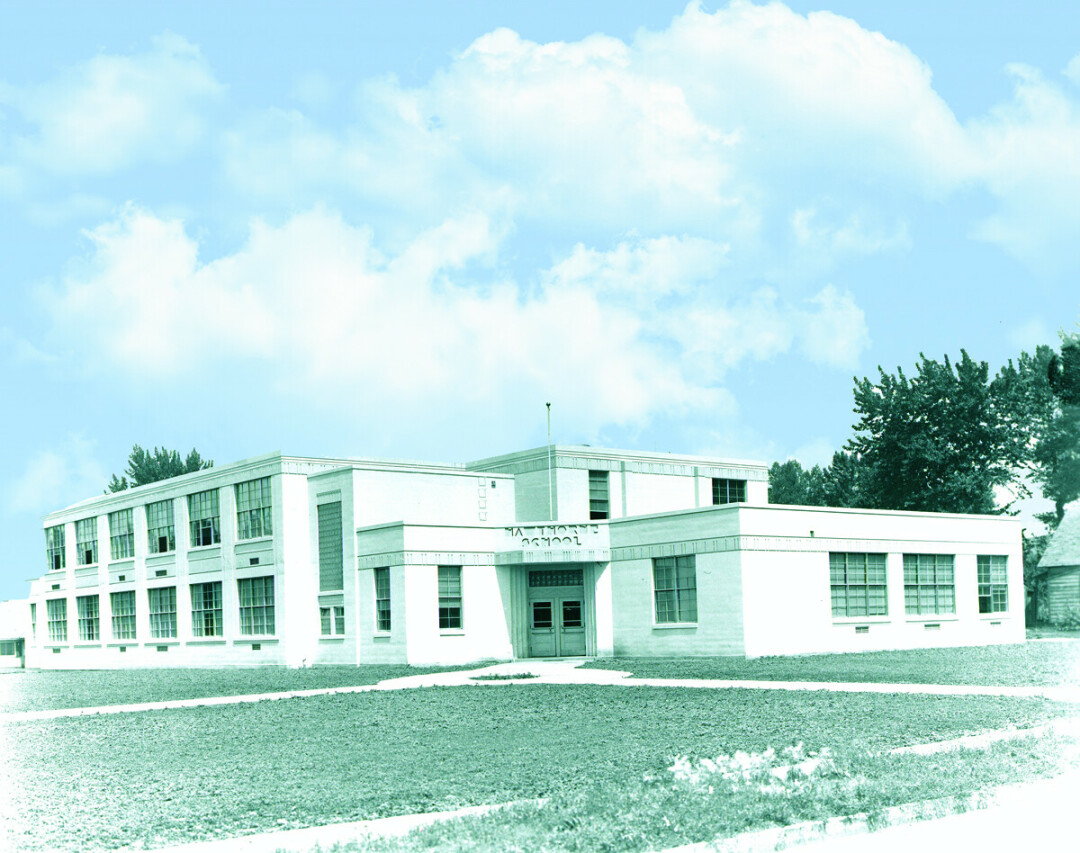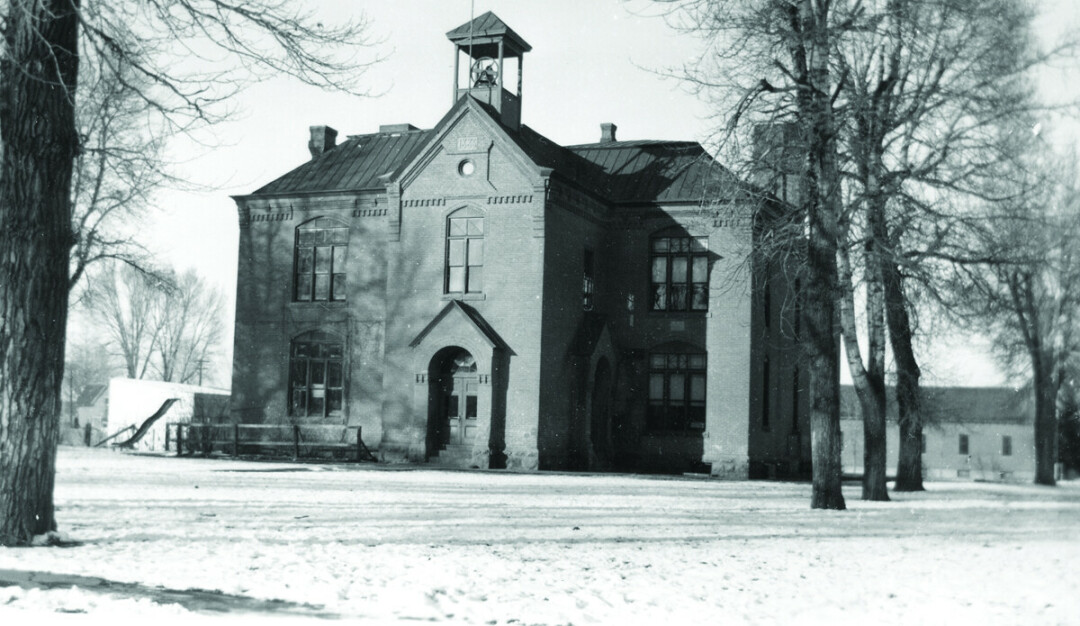The History of Hawthorne
East Side School to Art Deco Hub
Sunday Sep. 1st, 2024

Hawthorne School is a familiar sight to both locals and visitors alike. It sits at the prominent corner of Rouse and Mendenhall streets, visible to anyone heading into downtown from the north side or heading towards the Bridger mountains from Main Street. Although the current building was built in 1939, Hawthorne School has existed on the stretch of land bordered by Church Street on the west, Lamme Street on the north, Rouse on the west and Mendenhall on the north in some form since 1883.
The very first school in Bozeman was started in 1865, and was intended to promote a more family-friendly perception of the town. Classes were only offered during the cold winter months. In 1877 William Beall constructed a brick schoolhouse called the West Side School. This building was demolished and rebuilt a decade later in 1887. This school would eventually become the Irving school. In 1882 there was a call for a bill to fund an east side school in the town’s paper The Avant Courier. The school districts were blocked out as “all such scholars living east of Bozeman Street shall attend the east side school house, all living west of Bozeman street shall attend the old school house.” In July of 1883, Nelson Story and E.W. Carpenter of San Francisco purchased a total of $10,000 in bonds to fund the school. School trustees purchased ten lots from a Mr. Charles Rich with frontage of 140 feet on Mendenhall Street and 300 feet of frontage on Church Street for a cost of $1250. 
Building went quickly and the East Side School was finished by November of 1883. The building itself was designed by architect Byron Vreeland, who had also designed the Story Mansion, City Hall and the Opera House. August Zietzke built out the straight-sided mansard roof, prominent cornices, and a central gabled pavilion of Vreeland’s design for a total cost of $11,900. It was reported that the “massive structure will long live as a monument of good taste, fine workmanship and a live school board.” In May of 1884 the residents of the east side donated “liberally” for improvements including water on the grounds, and the planting of 160 shade trees. In 1891, a bell tower was built to help combat tardiness. It was “gratifying news to both parents and children in that part of the city.”
The first teachers hired at the school were a Mrs. A.G. Smith and Miss Cora E. Bates. The school housed grades 1-8; first grade was also called the primary grade. As early as 1884, there were complaints that the primary grade was overcrowded, and there were requests for more teachers. By 1887, there were seventy students enrolled at the East Side school. In 1892 the board of trustees of school district number 7 requested bids for another schoolhouse and a four-room addition to the East Side School. In 1918, when the Emerson Junior High School was built, Bozeman’s elementary schools changed to house only grades 1-5 (although due to overcrowding and various other events, this changed depending on the year). During the national flu epidemic of 1919, the Emerson building was used as a care center to treat patients, so that year the children were all taught in the elementary school buildings.
The life of a student in the early twentieth century could be difficult, and this is most obvious in terms of concepts of discipline. Corporal punishment was seen as an acceptable form of discipline. In 1892, H.E. Wolfe was hired as the new principal and, as was quoted in The New Issue, “impressed to the boys that he will not be trifled with.” In 1900 he was joined by Miss Josie Pepper who was hired to teach grades 3 and 4 and to dole out “a little physical training.” In 1901, a teacher, Miss Beula Walker, was arrested for whipping sixth grader Lulu Alexander with rawhide. The case was later dismissed. H.C. Good, the principal, was arrested and fined for “Brutal Treatment to one of His Pupils” in 1903, as reported in the Avant Courier. He was fined $35 for hitting thirteen-year-old Elsie Cornell with a rawhide so badly that she had lacerations on her arms and shoulders. The fine was not seen as punishment enough by Elsie’s father. Mr. Cornell and an associate went to the house where Mr. Good boarded and “gave him a threshing.” The two men were also arrested and fined. An editorial in the Montana Daily Record stated, “the time will come, just the same when assault and battery, whether practiced by roughs on the highway or teachers under the thin disguise of ‘corporal punishment’ will not be tolerated by public sentiment.” Thankfully, that time would come.
In 1905 a third elementary school was built, and required a name change from the simple East and West side schools. Following the trend of the time, all three schools were named after authors: Hawthorne, Irving, and Longfellow. H.C. Good was still the principal in 1906 and was paid $100 a month for watching over the 275 children enrolled at Hawthorne. The classroom teachers received $70-80 a month. There were complaints that Bozeman was underpaying teachers by $5-10 a month in comparison to other Montana cities.
In an era before antibiotics and vaccines, Hawthorne students’ lives were impacted by illness. It was reported in 1886 that despite a student being infected with scarlet fever, there was no threat at Hawthorne. A health officer had visited the child and “all necessary precautions to prevent contagion had been taken; bedding and clothing had been burned and furniture disinfected.” In 1895, the school board met to discuss the issue of measles in the schools. They found that only one case had been reported at the East Side School, so it was premature to close the school. Numerous students were unable to receive their honor diplomas for attendance because they had come down with the mumps and measles in 1914. Many classrooms were reduced to 9-12 students because of the outbreak. In the fall of 1916, there was a recalcitrance among the parents of the youngest children to start them in school, as they were worried about “infantile paralysis,” or the polio virus. Scarlet fever was reported once again in 1917 and the Bozeman Daily Chronicle ran an article titled “Public Health is Purchasable,” giving parents detailed information on childhood diseases such as whooping cough, chicken pox, and diphtheria.
Considering the concerns about disease transmission, it is no surprise that many of the social movements that started around the turn of the century were focused on health. The first parent-teacher association in Bozeman was formed that year. Another socially minded group was Hawthorne’s Mother’s Club, which implemented a program that provided hot lunches and showers to students in the school building. Mrs. Lehrkind was the group’s leader. The focus of many of these groups was public health. In the fall and winter of 1915, medical inspections were carried out at Hawthorne. These inspections were intended to catch any medical issues in children, such as vison or hearing loss, and to provide early intervention. Other hygiene measures were taken within the school. The school board voted to fix toilets and hire a school nurse in 1916. Mary Agnes Rust worked as the school nurse until she joined the Red Cross in 1918 and was dispatched to France to aid the war effort. During her time at Hawthorne, she supervised the “little folks” during their weekly hot shower baths.
Upon the United States’ entry into World War I in April of 1917, the nation’s children and adults alike fervently joined the war effort. The students at Hawthorne were no different. Many of their efforts were spearheaded by Miss Dorothy Gatton, who had two brothers serving in the war, Cy Gatton, and Walter Gatton. Walter was among one of Gallatin county’s first contingent of drafted men. Miss Gatton’s second grade class gave two bags of apples to the draftees heading out of town. The children also participated in “Conservation Food Week,” abstaining from candy on the weekdays, and eating no more than four pieces on the weekends. All through 1917 and 1918, Hawthorne students did their part by going “over the top” in Junior Red Cross Subscriptions, buying thrift cards and war savings stamps with their pennies and participating in patriotic parades around the school grounds.
Safety continued to be a driving force in school activities and reform. In 1919 the city passed Ordinance 490, which imposed 10 mph speed limits around schools, and outlined a fine structure for violators. Hawthorne began running fire drills and bested Irving and Longfellow when they were able to move 260 students out of the building in 55 seconds. By 1926, two-and-a-half lots facing Lamme Street had been purchased to be a dedicated playground for the school.
The Great Depression led to an important era of schoolhouse design and construction in Bozeman. The city, like many others in the late 1930s, secured New Deal funding through the Public Works Administration to build new buildings for its three original elementary schools, and to build a new high school (now the Willson School). The new Hawthorne building was proposed in 1937. Fred Willson was the architect, and embraced the Art Deco style of the day. Construction began in 1938 and finished in November of 1939, with the official dedication ceremony on December 1, 1939. That year, The Bozeman Courier reported that Hawthorne pupils had buildings to be very proud of: “The building is regarded by authorities as being one of the most modern and up-to-date buildings being used for grade schools in the United States.”
Hawthorne is now one of eight elementary schools in Bozeman. In 1991, it was made a Model School for the Integration of the Arts. It continues its mission to bring art to the classroom today. Each spring, the children put on a “Celebration of the Arts” event. The school’s mascot is a hedgehog holding a paintbrush. In 2017 the school was again expanded; five new classrooms were built. It now houses 348 students in grades kindergarten through fifth grade. Hawthorne is still a centerpiece of Bozeman’s public school district, much loved by current and former students and families alike.
Vickie Lyons has lived all over the West but has called Bozeman home for seven years. She is a member of the Extreme History Project and when she isn’t researching hard history, she enjoys spending time with her husband and two kiddos, both indoors and out.
| Tweet |